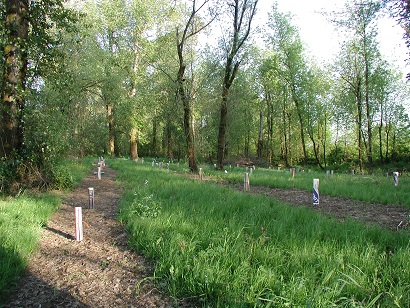Brad Withrow-Robinson, Extension & Natural Resources Extension agent for Benton, Linn and Polk Counties.
Spring is the key time to tackle many non-woody weeds. These non-woody (also called “herbaceous”) plants include grasses and many common flowering plants including clovers, thistles, oxeye daisy, tansy ragwort and groundsel. There are many native and also non-native herbaceous plants in the fields and forests of Oregon.

Taking care of unwanted plants/weeds in often an important part of taking care of your land. Herbaceous weed control if often part of these common objectives:
- Successfully planting tree and shrub seedlings
- Reducing fine fuels defending against wildfire
- Enhancing forest diversity/improving wildlife habitat
- Easy access and enjoyment of your property
NOW is good time to get out on your property, take a look and assess the situation: What needs to be done, to accomplish what, by when? You might start by considering any of the items in the list above.
- If you have newly planted seedlings, you KNOW you will need to reduce competition in the first two years if they are to survive.
- Fire prevention strategies like Defensible Space focus on reducing fire fuels in different zones around the home. This often includes mowing strategic areas to prevent accumulation of dry grass and other fine fuels that could carry the fire to the home. To be effective, fields must be mown early and often to allow material to rot away. June is often too late to be very effective!
- Our forests are home to a wide variety of native plants. Invaisve plants such as false brome, or shining geranium can crowd out many native woodland plants, reduce the diversity and lessen the habitat value of your woodland. Keeping invasives in check to favor native plants is often a key strategy in a conservation plan.
- How can we play in our woods with all these blackberry vines? Take control of favorite areas, pathways.

Although you may find you have a clear motivation for managing invasive weeds or other unwanted vegetation, what to do may be less clear. Different woodland conditions, situations and landowner objectives will justify using different approaches to vegetation control. These include: manual and mechanical methods such as mowing, grubbing or pulling; cultural methods such as grazing; or use of chemical herbicides. How appropriate each is depends somewhat on the weeds in question, the purpose of the action (to remove or to kill), and season of use (which has a strong impact on effectiveness).
A good resource to explore those many options is the TNC Weed Control Methods Handbook: Tools and Techniques for Use in Natural Areas.
Often, the size of the task leads many people to decide to use some herbicides to meet their objectives. There are a variety of allowable products and methods to choose from. It is important to be informed about materials and rules involved. The use of chemicals in forestry is more regulated than in most other rural or urban land uses. Remember that Oregon forest practice rules require Notification to the Oregon Department of Forestry ahead of use.
Also, responsible use of herbicides means careful selection of appropriate materials and correct application methods. The PNW Weed Management Handbook is a vital source of information on safety, selection and use of herbicides.
To find a refresher on backpack use and calibration (soon), mixing (also soon), or other information to help you manage vegetation, click on “Weeds” in the Tags box on the right side of this screen.
